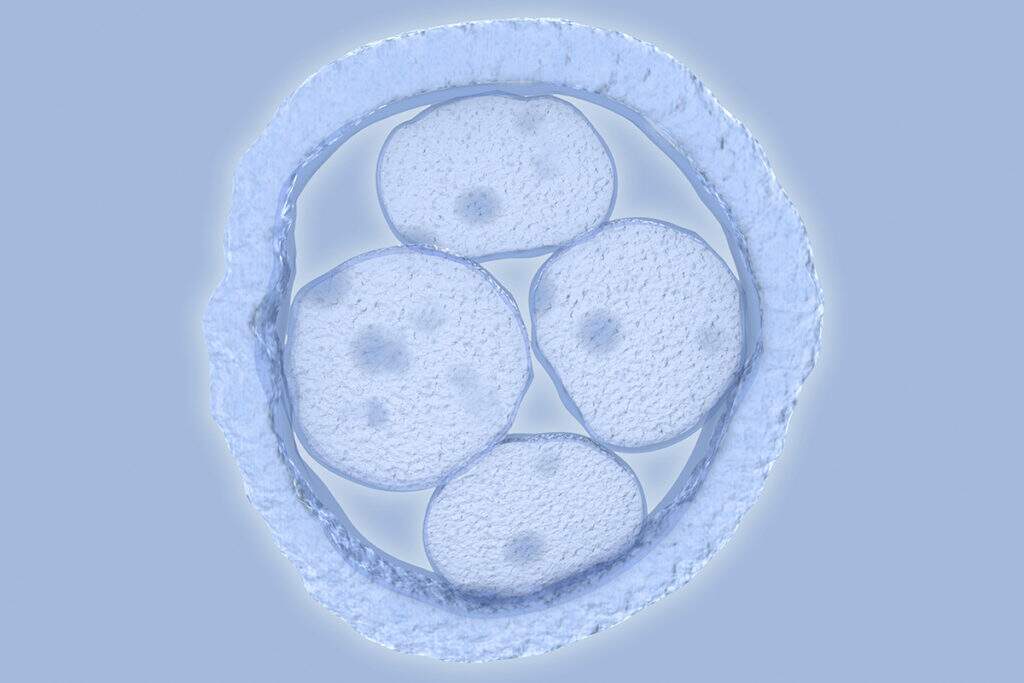A team in China has corrected genetic mutations in at least some of the cells in three normal human embryos using the CRISPR genome editing technique. The latest study is the first to describe the results of using CRISPR in viable human embryos, New Scientist can reveal.
While this study – which attempted to repair the DNA of six embryos in total – was very small, the results suggest CRISPR works much better in normal embryos than it did in previous tests on abnormal embryos that could not develop into children.
“It is encouraging,” says Robin Lovell-Badge of the Francis Crick Institute in London, who has contributed to several major reports on human genome editing. The numbers are far too low to make strong conclusions though, he cautions.
The CRISPR gene editing technique is a very efficient way of disabling genes, by introducing small mutations that disrupt the code of a DNA sequence. CRISPR can also be used to repair genes, but this is much more difficult.
Until now, results have only been published from experiments in which the CRISPR technique was used in abnormal embryos, made when two sperm fertilise the same egg. The idea behind this work was that it was more ethical to test the technique on embryos that could never fully develop.
In the first attempt to fix genes in human embryos, fewer than 1 in 10 cells were successfully repaired – an efficiency rate that is too low to make the method practical. A second study published in 2016 also had a low rate of efficiency. However, because these embryos were very genetically abnormal, these experiments may not have given an accurate indication of how well the technique would work in healthier embryos.
The Chinese team behind the latest study, at the Third Affiliated Hospital of Guangzhou Medical University, first carried out experiments with abnormal embryos, and found the repair rate was very low. But they had more success when they tried to repair mutations in normal embryos derived from immature eggs donated by people undergoing IVF.
Genetic disease
Immature eggs like these are usually discarded by IVF clinics, as the success rate is much lower than with mature eggs. However, children have been born from such immature eggs.
Jianqiao Liu and his team matured donated immature eggs, and fertilised each by injecting sperm from one of two men with a hereditary disease. They then injected the CRISPR machinery into these single-cell embryos before they started dividing.
The first sperm donor had a mutation called G1376T in the gene for the G6PD enzyme. This is a common cause of favism in China, a disorder in which eating certain foods such as fava beans can trigger the destruction of red blood cells.
In two of the resulting embryos, the G1376T mutation was corrected. But in one of the embryos, not all the cells were corrected. CRISPR turned off the G6PD gene in some of its cells rather than fixing it – making it what is known as a “mosaic”.
The second sperm donor had a mutation called beta41-42, which is one of the causes of the blood disease beta-thalassemia. Four of the resulting embryos carried the mutation. In one, CRISPR induced another mutation rather than fixing the beta41-42. In another, the mutation was successfully repaired in only some of the cells, creating another mosaic embryo. It did not work at all in the other two embryos.
In total, the mutation in one embryo was corrected in every cell, and two were corrected in some of the cells.
While firm conclusions cannot be drawn based on just six embryos, these results are encouraging as they suggest CRISPR gene repair is more efficient in normal cells. “It does look more promising than previous papers,” says Fredrik Lanner of the Karolinska Institute in Sweden, whose team has begun using CRISPR to disable genes in human embryos to study embryonic development.
Preventing mosaics
Several other groups have begun editing the genomes of normal human embryos or plan to start soon. There are rumours that another three or four studies on the use of CRISPR in human embryos have been completed but not yet published. It isn’t clear why this is the case, but the controversy surrounding the area may have made both researchers and journals wary.
The results so far, however, show the technology is far from the point where it could be safely used for editing embryos.
To make it safer to use gene editing to prevent children inheriting disease-causing mutations, researchers will need to find a way to prevent mosaicism. Edited embryos would always be tested before being implanted in a woman, but if they are mosaics such tests cannot guarantee the resulting child will be disease-free.
“This would need to be solved before the methods could be used clinically to correct a disease,” says Lovell-Badge. Progress is already being made: at least two teams have already found ways of reducing the risk of mosaicism in animals.
Mosaicism could also be avoided by editing the genomes of sperm and eggs prior to IVF, rather than embryos. This is expected to become possible in people in the next few years.
There are also a few diseases where mosaicism might not matter, Lovell-Badge points out, such as metabolic liver diseases where only 20 per cent function is enough to keep people healthy.
However, a major report on gene editing by the US National Academy of Sciences recently concluded that trials of germline gene editing should be allowed only if they meet a number of criteria – the first being “the absence of reasonable alternatives”.
Yet almost all inherited diseases can already be prevented by existing forms of screening, such as testing IVF embryos and implanting only disease-free ones. There are only a small number of cases where this method – called preimplantation genetic diagnosis – will not work because none of a couple’s embryos will be disease-free.
Journal reference: Molecular Genetics and Genomics, DOI: 10.1007/s00438-017-1299-z


